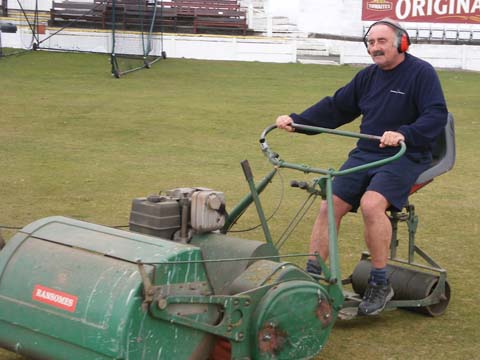|
Latest
|
GROUND DIARY 2013
 Ian in action |
|---|
The coldest march in 50 years. March was colder than Dec ,Jan and Feb. . It must be bad news for the ground and groundsmen?
Not necessarily, there are positives. I’m in my second week back at A.C.C. since last September. So far I’ve been pleased with ground progress. Football has finished on the Highams and Huncoat sides of the ground. The outfield has been rolled and cut. Little damage has been done through football. I think we should have verti-drained both pitches when the square was verti-drained last back end. Accy’s ground is naturally free-draining, but with a mossy, thatched outfield and with winter sport plus water run-off from Higham’s cycle track, aeration is necessary. I estimate for a small cost by a friendly foreigner approximately a quarter of a million holes, to a depth of six inches would have greatly benefited an outfield that, save mowing, receives little attention. Leave now, pay later, and at a much greater cost.
The cold weather has meant no grass growth and poor colour, but on the plus side, less mowing. The hardest cut of the year is the first. In spring the ground has been softened by winter rain, loosened by frost, perhaps with some growth and usually with plenty of worm casts. Not this year. A nice dry cut of the square and the outfield was completed last week. In cold, dry weather worms go deeper in the soil and therefore don’t cast. Of course, overnight frost stops any work on the ground. However, by 10a.m. the sun has usually removed the frost to enable work to start.
Today I thoroughly scarified the square, in three directions, with a super machine loaned by a friendly foreigner. The books tell you to lightly scarify in spring and harder in autumn. Blow that, I took advantage of the machine, took off 36 box loads of thatch, moss, dead grass and, no doubt, some healthy grass. Groundsmanship is not an exact science and I always say “that grass is a tough cookie”, especially during the growing season. Although after scarifying the square it looks paler in colour it will recover when the weather warms up and new growth and new shoots appear. It’s no good fertilising to green up the square with present temperatures. Why force lush green growth in freezing conditions? I’ll fertilise when temperatures are on the up in mid April and reseed the football goalmouths at the same time. Yesterday I re-measured and remarked all the wickets on the square.
Jimmy Hayhurst has been doing several jobs down at the ground. He’s measured, dug and concreted in the uprights for the two new frames for the new artificial surfaces and today, on his own, managed to erect the net over both frames. A hands on member for sure. No news on the laying of the artificial bowling ends for these wickets or the construction of the new artificial wicket at the cemetery end of the square. I had hoped that this work would have been completed by now, and certainly by the start of the season. I hope that the old, damaged, lightweight net frame be dismantled and last season’s new, movable frame be used for the new artificial wicket on the square, or, if needed, a grass wicket.
Rod and Colin have been sorting out paint for the clean-up day on Sunday 14th April, also, with Phil, they have been sorting out and delivering memberships. New advertising boards have been erected. Colin Berry’s done a great job on the sponsorship side. Ian Wilcox is to continue mowing and strimming the perimeter areas, thank goodness. The netting behind the wicket at the Huncoat end is shot at and needs replacing or removing. The wooden sightscreen that Bert repaired so many times still needs regular replacements and hopefully the see-through sightscreen, on a metal base at the Higham’s end, will be replaced with traditional wood, thus making the ground look like a cricket ground.
Little pre-season rolling has been done so far. The idea of pre-season rolling is to consolidate and firm the wickets while there is moisture in the ground. So, when the summer starts, less watering and rolling are needed on the wickets. Fat chance of that happening over the last few year especially in Lancashire! The driest weather has been in spring and the wettest in summer! However I left the ground yesterday with Arthur rolling away with gloves, several jumpers and, count them, two jackets on.
Tomorrow I’m going to remark the boundary line with weedkiller. It will clearly identify the line for 2-3 months without the need to keep marking it out each week, saving money and time. I will remark it in July by which time the rain will have arrived! Is part of the attraction of league cricket the struggle against the odds? Or perhaps we live in hope that good weather and a trophy are on the agenda.
IAN MAC